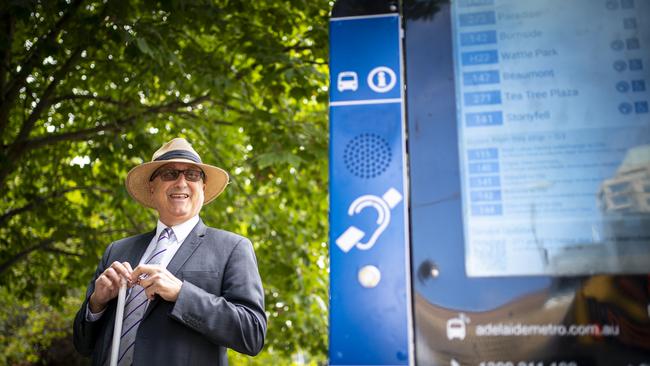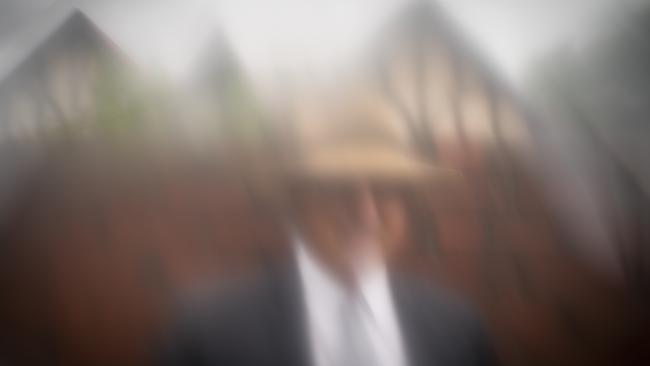I went ‘blind’ but gained new insight on Adelaide’s buses
Jennifer Hullick dons “blindness” goggles to learn how the vision-impaired use public transport – and finds it extremely challenging. Pick up the Sunday Mail this weekend for our new magazine focusing on life for people with disabilities.
SA News
Don't miss out on the headlines from SA News. Followed categories will be added to My News.
Read more stories like this about life for people with disabilities in new magazine Posability, inside the Sunday Mail this weekend
- RSB calls for national card for guide dogs
It’s close to midday on a busy Tuesday in February and, although I have been told I’m standing in the middle of the city, I have no exact idea of where I am.
I am taking part in an experiment to try to understand what it is like to have low or no vision while using Adelaide’s public buses. The adventure has been sparked by problems experienced with the audiovisual announcement system being trialled on some buses. The “Next Stop” program was forced into a reboot last year when it mispronounced street names and announced the wrong locations for upcoming bus stops. At the time of writing, the Department of Planning, Transport and Infrastructure was evaluating the program. But for people with low or no sight, what is it like catching a public bus without the Next Stop system in place?
Luckily, willing staff from the Royal Society for the Blind (RSB) have taken me by the hand for this journey – literally.

The expedition begins with my introduction to Tony Starkey, RSB policy, accessibility and client consultation officer, who lost his sight suddenly 50 years ago as a teenager.
Over the years, he has learned the many skills needed to navigate the public transport system, catching the bus to and from his city office every day, mostly without strife.
“Ninety per cent of your mobility is mapping to know where you are,” Starkey says. “So as much as we can become independent, you can’t just go wandering down the street thinking it will all work out for you because you can’t work out where things are with no reference points and landmarks.”
He found his one experience of the Next Stop system helpful but has learned to use other aids to find his way, including a phone app that tells him when the next bus is due and where it is going, and the audio cues available at talking bus stops set up at many CBD locations.
Despite his confidence, today we are taking a bus route unfamiliar to Starkey and he has his own sighted guide, RSB executive manager marketing and fundraising Darrin Johnson.
My guide is Gayle McPherson, RSB orientation and mobility instructor, who explains the set up of the R1 bus stop on Grenfell St. It is missing the Tactile Ground Surface Indicators (TGSI) meant to be laid into the pavement. These are simple concrete pads with parallel raised lines or bumps used to give blind pedestrians warning of hazards and directional information.

Johnson has guided Starkey to this unfamiliar stop but now he is on his own, white cane in hand. This location is not equipped as a talking bus stop, so Starkey is listening to his phone app to hear which bus is approaching. The bus stops and Starkey confirms the bus number and route with the driver before using his cane to navigate to the nearest empty seat.
As the bus heads west towards Henley Beach Rd, Starkey explains that, as well as good preparation, he relies strongly on his other senses to use public transport. “If it’s a busy day, you just count the number of times you stop,” he says. “If I think I’m getting close, I move up and ask the driver where we are.
“You’ve got to use your knowledge to know where you are. The driver usually asks me where I want to get off but if he gets busy he may forget, so you’ve got to have a rough idea. If he goes past the stop, you’ve got to know where you are so you can cross the road or go back or whatever.”
My turn comes after we exit the bus at Stop 8 on Henley Beach Rd. Chosen randomly, the stop demonstrates the hazards for the vision impaired, with a large light pole positioned in the footpath close to the middle exit door. There are TGSI markers at this stop but they are rough and ready, even more so at the intersection where we cross the road to catch a bus back into town.
Here, I don the first set of goggles, meant to demonstrate low vision. It’s like wearing very, very scratchy glasses. I can perceive colours and shapes and the outlines of the faces around me but no detail. My depth perception is severely diminished.
The next glasses simulate having cataracts and the shapes around me are far more blurry. I can still see bright colours and human shapes, but I can’t see faces or read people’s expressions. I am about 2m away from the bus stop and I can’t read what stop number it is.
Behind the glasses, I would be lost if left to use public transport alone but McPherson guides me aboard the next bus, where I take my seat. Finally, the real challenge begins, as I am fitted with goggles that leave me in total darkness. I immediately feel disoriented and quite alone, even though I can hear people’s voices. It’s disconcerting not knowing if people are speaking to me or just chatting nearby.
McPherson instructs me in the use of the long white cane used on public transport. The swivelling ball on the end helps feed back tactile information to the holder and it helps me feel more in touch with the surrounding environment.
I can hear the bus is now in busy traffic and assume we are back in the CBD. I can feel the bus turn a corner but I am so disoriented, without audible announcements about our location, I am just guessing.
My helper instructs me on how to use the cane as I step down from the bus but I keep a firm grip on her arm all the same. That step out into thin air is a nervous one but I land safely and take slow steps forward.
“How’s the speed?” asks McPherson. “OK,” I reply. I feel as if we are moving at a moderate pace across the pavement but she tells me are actually moving pretty slowly. A look at the video later confirms how radically my perception behind the goggles is out of kilter with reality.
On the last leg, McPherson teaches me how to negotiate a road crossing. The TGSI markers are more useful now that I am more familiar with the white cane. I make it to a park bench in Hindmarsh Square where I find considerable relief in removing the goggles.
Despite all the guidance, I feel quite overwhelmed by the experience. I think I now understand a little of what it’s like to navigate your way through life without the use of your eyesight but, as an honorary blind person, I’ve got a lot more to learn.
There is now no doubt in my mind that the more the transport system can do to increase audio and visual cues for people with blindness and deafness, the more the transport system will be accessible, and the more people with these particular types of disability can live their fullest lives.
